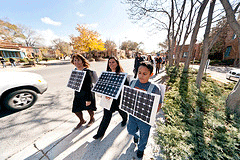
An affordable housing complex put solar panels on its roof!
Also, it's affordable “community solar,” meaning you can invest in a piece of it for $150 (instead of, say, $10K to buy your own array, or minimum $500-$1400 in other joint solar investments) and earn a return in lower energy bills as you share in the electricity the panels generate. You'll at least break even in five years.
The article is pretty gushy about it—this is about the “real sharing economy“ and following Naomi Klein's dictum that “the people who got the worst deal in the old economy should be the first in line to benefit in the new economy.”
Splendid—some of the returns of the solar revolution going to folks without the resources to put up solar themselves. I'm all for that.
But then I realized the “community” part and the where it's located part didn't seem connected. Somewhere buried down at the end of the article is a concern that seemed to me to be a fairly big point—none of the people living in the building have bought in. In fact, none of the residents of Capitol Hill Housing's 48 affordable housing properties have. Even $150 is probably a bit much for them to put up just because it's the right thing to do, since the return is fairly slow.
That sounded bad to me—I actually started writing this post as a disappointed, “gee that doesn't sound so great after all” post.
But then a I poked a little further and found that one of the crucial points wasn't mentioned in the first article at all—after the initial 5 year investment period, the solar array will be donated to the affordable housing nonprofit that owns the building to “reduce the long-term operating expenses of affordable housing.”
Now we're talking! Community investment, a modest return, locally sourced parts and labor, increased distributed capacity attached to the grid—and eventually reduced utility costs specifically for affordable housing. That could be a pretty great model.
What do you think? Would you host a project like this on your roof for benefits starting in 5 years?
(Photo credit: Flickr user WildEarth Guardians, CC BY-NC-ND 2.0)





Comments